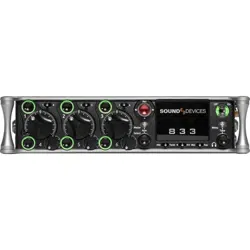Loading ...
Loading ...
Loading ...

Phase
The relationship one audio signal has in time with respect to another audio signal, defined in degrees of phase. When audio signals
are generated at identical times, they are “in phase” with each other. When one audio signal is time-delayed with respect to another
the signals are “out of phase”. Differing phase relationships can be introduced several ways, including when microphones are placed
at varying distances from a sound source, or electrical/digital delay is introduced to one signal with respect to another.
Phrase
A pre-set text string which can be used to quickly fill out the notes field.
Pre-fader routing
The signal from a channel is routed to a bus before the fader in the signal path. The input trim, if available, controls the channel level
sent to the bus. Isolated tracks are typically recorded pre-fader so that any level changes made to the faders don’t affect the
recorded signal.
Pre-roll
A continuous buffer that is always writing to memory offering a recording that begins prior to when the record button is activated.
Pre-roll is set in seconds, and the recording begins the set number of seconds prior to the button being pressed. This is helpful in
applications where an operator missed a cue to begin recording.
Polarity (audio)
The direction of the current flow of an audio signal is defined as polarity. The polarity of a signal can reversed when a balanced
audio signal connection has its pin-2 and pin-3 connections reversed. Single-ended signals can have their polarity reversed when
going through an “inverting” gain stage. It is best practice to have all incoming and outgoing signals with the same polarity
relationship.
Polyphonic WAV
An individual WAV file that contains multiple audio tracks. When recording multi-track audio with polyphonic WAV files all recorded
tracks are contained within a single WAV file.
Post-fader routing (after fade routing, AFL)
The signal from a channel is routed to a bus after the fader in the signal path. The fader controls the level of the channel at the bus.
Channels sent to a master bus, such as the left/right bus, are typically sent post-fader.
Post-roll
An extra period of time that is appended to the end of a recording when stop is pressed. If record is pressed during this period of
time, recording will resume within the same file with no audio lost. This is particularly useful should a Director call ‘cut’ prematurely
or accidentally.
Project
An option available for file organization on Sound Devices recorders. Projects are the highest level of file folder organization. The
project folder can contain sub-folders of scene files or recorded files directly.
Record bell
A tone generated in headphones to alert the listener that recording has started. The bell is also produced when recording has ended
with the stop button, when the recording volume is full, or when power is in a critical state.
Record Folder
The destination folder for recorded takes. The 8-Series supports a three-tier folder hierarchy allowing for flexibility in organizing
recordings.
Sampling rate
When converting between analog and PCM digital audio the analog signal is measured (sampled) in unique steps at a data rate
specified in kHz. Higher sampling rates allow for representing higher frequency analog audio. 48 kHz is the standard sampling rate
for production, worldwide. Higher sampling rates including 96 kHz and 192 kHz are used for high-precision applications where the
representation of audio above 20 kHz is required. A general rule is that the maximum analog audio frequency is ½ the sampling
rate.
Scene
On Sound Devices recorders the scene becomes part of the file name for a take. Scene names can be pre-loaded to quickly change
between scenes.
833 User Guide 117
Loading ...
Loading ...
Loading ...
